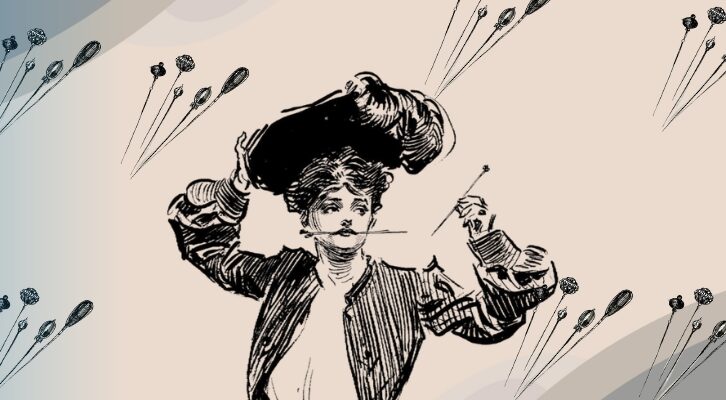
Dystopia For Sale: How a Commercialized Genre Lost its Teeth
Overdosing on Stories of Futility Might Be Bad for Us
When Hulu’s The Handmaid’s Tale won last year’s Emmy for Outstanding Drama Series, showrunner Bruce Miller invited Margaret Atwood, whose 1985 novel inspired the show, to come on stage to help accept the award. The series, about a totalitarian America that enslaves women for reproductive purposes, was the most lauded show of the night; the series won several additional awards and Hulu became the first streaming service to win the top Emmy prize. Atwood’s presence on stage seemed like a crowning moment for a series that, less than a month before Jodi Kantor and Megan Twohey broke the news on Harvey Weinstein, already felt timely. For many Americans, watching this show summed up how bleak and discouraging the world felt in 2017. An Emmy win could perhaps validate that seemingly omnipresent feeling that yes, times are this bad and something has to be done. The moment, however, belonged to Hulu.
“It’s been lovely,” Miller said to a room full of millionaires and Sean Spicer. “Go home and wrap it up. We have a lot of things to fight for.”
Backstage, Atwood talked with reporters about the win. “My takeaway would be never believe it could never happen here,” she said. “There was nothing that went into the book that people hadn’t done at some point in time in some place.” Like Miller, her comments were inspiring and also somewhat vague. Then Atwood, after discussing Volker Schlöndorff’s 1990 film adaptation of The Handmaid’s Tale, began enumerating the other adaptations of her novel:
It’s also been an opera, it’s been a ballet; it’s being turned into a graphic novel right now . . . . There’s also a short on YouTube called, “They Finally Made A Handmaid’s Tale For Men.” So it’s gotten out of the box. People are sending me knitted chickens with little handmaid’s outfits on them. And they’re sending me photos of their dogs and cats [dressed up]. It’s out there in the world. It’s also become a theme for state legislature protest. You could say the handmaids have escaped. They’re out there. And they’re coming to you again in season two!
Atwood’s closing plug for season two, however tongue-in-cheek, was not what I expected. In my arrogance—or naiveté—I was ready for Atwood, who had created this scary yet plausible future, to launch a call-to-action, to tell me what I could do to stop her vision from becoming reality. Wouldn’t she, having created a version of this world, know how to stop it?
I knew I should have been happy for Atwood. The Handmaid’s Tale is an excellent and necessary book that has now reached a new audience through the TV series. Atwood deserves to enjoy the fruits of her labors, and she owes me nothing. I would love to believe that someone watching the show might be compelled to take action rather than sitting around and knitting chickens while waiting for season two to tell them how bad things are. But we live in a world of screens. The show, whether we want it or not, is inescapable. It’s easier just to tune in and watch what happens next.
*
The Handmaid’s Tale’s renewed success, George Orwell’s 1984 jumping back onto the bestseller list, and the onslaught of headlines touting the idea that everything is suddenly happening “now more than ever” point to an idea that’s really gained traction within the last year: we are already living in a dystopia.
The word “dystopia,” in a divided time in America, is cool again. Cool, overused, and, at this point, abused.
“It’s fashionable to be pessimistic,” Vulture declared in August in its listicle of the 100 greatest works of dystopian fiction. Name any bleak future-that’s-actually-happening-now and there’s a recent book (American War, The Book of Joan, NK3, Borne), film (Z for Zachariah, The Lobster, Advantageous), or TV show (The Handmaid’s Tale, Black Mirror, 3%, The Man in the High Castle, The 100) to reassure you fears are legitimate and confirm your worldview. Whatever your biggest concern—political polarization, climate change, the oppression of people of color and women, the unchecked evolution of technology—there’s a nightmarish fictionalized future already waiting for you. And if you want to be really informed, you can surround yourself with every potential bleak outcome. Everyone is allowed their own dystopia; they’re as easy to personalize as an iTunes playlist.
Once an ambitious medium of social and political criticism, dystopia has been reduced to a buzzword that can be slapped onto anything to sound engaged. The word has not yet become totally meaningless—it still evokes a certain dread, and great dystopian art is still being made. But there’s too much of it. We already know there are endless reasons to be afraid, that no one acting alone can change the future. We are overloading on dystopia.
Many people of my generation first formed an understanding of dystopia from reading 1984 and Aldous Huxley’s Brave New World in school. We grew up on Big Brother, and now we retreat to these scary fictional worlds when anything in real life begins to vaguely resemble them. When these stories, many of which contain anti-capitalist or anti-consumerist critiques, become newly popular, they are inevitably adapted into shows, films, or Apple commercials. Just as we’re going to get a new Star Wars film every year until the end of time, we’re being told the same dystopian tales we learned as freshmen in high school over and over, many of which were written long ago and, as Angelica Jade Bastién points out, are starkly white. We’re stuck seeing the world as 15-year-olds.
“Dystopia used to be a fiction of resistance,” author and historian Jill Lepore wrote for the New Yorker in June, “[now] it’s become a fiction of submission, the fiction of an untrusting, lonely, and sullen 21st century, the fiction of fake news and infowars, the fiction of helplessness and hopelessness.” Lepore continues:
[Dystopia] cannot imagine a better future, and it doesn’t ask anyone to bother to make one. It nurses grievances and indulges resentments; it doesn’t call for courage; it finds that cowardice suffices. Its only admonition is: Despair more. It appeals to both the left and the right, because, in the end, it requires so little by way of literary, political, or moral imagination, asking only that you enjoy the company of people whose fear of the future aligns comfortably with your own.
To Lepore’s point, we now mostly evoke dystopia not to resist but to hide. But Hollywood, more concerned with being on-brand than forward-thinking, wants to make us believe that a dystopian feminist show winning awards is some kind of meaningful change in itself.
“We grew up on Big Brother, and now we retreat to these scary fictional worlds when anything in real life begins to vaguely resemble them.”
With The Handmaid’s Tale specifically, when protesters dressed up as handmaids and marched on state capitol buildings, it came across, occasionally, as free publicity for Hulu in addition to meaningful protest. In fact, the first major handmaids protest was a literal Hulu promotion. “We’re not trying to make a political statement at all,” said Hulu’s head of marketing during the demonstration, which took place at last year’s SXSW.
In a nation full of political hobbyists, championing dystopian art has become a go-to for those who want to take a political stand without actually doing anything. But if we accept that we’re already living in a dystopia, then it’s too late. Life imitates art.
This is not a call to stop reading dystopian fiction. The world needs writers like George Orwell and Margaret Atwood to ask hard questions about our past, present, and future. But they are not enough. We also need to imagine a better future for ourselves, not as consumers—even of art and literature—but as citizens.
*
Dystopia is the antonym of “utopia,” Sir Thomas More’s term for an imagined perfect state that served as the title of his classic 1516 political satire. Utopia, in its original form, literally meant “no place.” If utopia is More’s unattainable ideal, then dystopia is its opposite: the unreachable nightmare. In 1868, British philosopher and economist John Stuart Mill confirmed this definition when he became the first person to use dystopia as its own word. “It is, perhaps, too complimentary to call them Utopians,” stated Mill in his Parliamentary speech criticizing Britain’s rule in Ireland, “they ought rather to be called dys-topians . . . what they appear to favor is too bad to be practicable.”
The earliest dystopian literature picked up on More’s and Mill’s view and, in a world that was still expanding, looked to the literal distance to create destinations unreachable and undesired. The first fictional dystopias were specific locations that coexisted within the authors’ real world: Jonathan Swift’s exotic islands in Gulliver’s Travels, Samuel Butler’s titular Darwinian land in Erewhon, or H.G. Wells’ future civilization in the time-hopping The Time Machine. The strength of these early works was that they provided an explicit contrast between the world as it was and as it might be. Lemuel Gulliver traveled to places like Lilliput, but he always came back to modern day England to ponder what he’d seen and how it changed his worldview. The reader might not agree with Swift’s conclusions, but he was making a clear critique.
In the progressive early 20th century, advances in technology (the Wright brothers’ flying machines, Ford’s first car, Marconi’s transatlantic radio signal) and New Imperialism made the world both smaller and more complicated, full of much potential and little precedent. New stories had to be written, so the next generation of dystopian writers looked to the future both to critique and escape the modern world. From E. M. Forster’s The Machine Stops (we all become dependent on one machine for all communication) to Yevgeny Zamyatin’s We (total surveillance, no free will) to Brave New World (we live on an assembly line), these stories were no longer strictly satires about politics already in progress but daring “what if” predictions. Readers were left to draw parallels between the work and their own realities to determine which far-future stories were serious warnings and which ones were just silly.
When the United States dropped the atomic bomb on Hiroshima, and it became clear that the world could now end with the push of a button, new stories had to be written. 1984, released in 1949, ended the “golden age” of dystopian writing on an artistic high note before writers shifted their focus to dramatic Cold War apocalypse scenarios. The new wave of dystopian literature—including Ray Bradbury’s Fahrenheit 451, Harlan Ellison’s I Have No Mouth and I Must Scream, and Alice Sheldon’s The Girl Who Was Plugged In—began to read more like pulpy science fiction novels, though diverse and challenging works emerged as well, such as William Gibson’s Neuromancer (the birth of cyberpunk), Anthony Burgess’ A Clockwork Orange (Orwell with a countercultural glee), and, of course, The Handmaid’s Tale (a stark tale of misogyny in an overwhelmingly male genre). By the end of the ‘80s, dystopia had evolved from a strict standalone genre to a popular, yet still effective, modifier for any fiction that wanted to predict a doomed future.
An arguably more significant evolution of dystopia, however, was happening not in books but on screen. The first great dystopian film is Fritz Lang’s 1927 classic Metropolis, but beginning in the ‘70s, several dystopian novels were adapted into influential movies, most notably A Clockwork Orange and Philip K. Dick’s Do Androids Dream of Electric Sheep? (retitled as Blade Runner). There were also new original dystopian stories, including THX 1138 (George Lucas’ directorial debut), Lizzie Borden’s Born in Flames, and Terry Gilliam’s Brazil. Onscreen, the future was still bleak, but now it was also explosive, sleek, and could be consumed in about two hours.
The next big dystopia boom centered on children and teenagers. Lois Lowry’s 1993 novel The Giver became one of the first popular dystopian novels written for a young adult audience featuring a young adult protagonist, and it opened the doors for countless YA dystopian novels—perhaps peaking with the multi-media franchising of Suzanne Collins’ 2008 novel The Hunger Games (and its many imitators). As for adults, dystopia continued to thrive more onscreen than on the page. (Koushun Takami’s Battle Royale and Kazuo Ishiguro’s Never Let Me Go are two notable exceptions.)
“Onscreen, the future was still bleak, but now it was also explosive, sleek, and could be consumed in about two hours.”
The Cold War was over, but the world was still a bummer, and many new dystopias were content to be the same—bummer escapisms. Films such as Mamoru Oshii’s adaptation of Ghost in the Shell, Kathryn Bigelow’s Strange Days, and the Wachowskis’ The Matrix took place in near futures that were all-knowing, all-controlling, with all-helpless populations. In the globalizing 21st century, the near future was sometimes funny (Mike Judge’s Idiocracy) but often it was just bleak (Alfonso Cuarón’s adaptation of P. D. James’ Children of Men, Neill Blomkamp’s District 9, and Bong Joon-ho’s Snowpiercer.)
And now TV, perhaps the medium most affected by the new world of streaming, has come into its own as a home for original or new adaptations of dystopian stories. Hulu’s The Handmaid’s Tale will be back for season two, Fahrenheit 451 is coming to HBO, and they will sit alongside an archive of new and adapted dystopian shows and other classic speculative shows and films that will be promoted as timely, over and over again.
*
Dystopia has moved from an explicitly political critique to a sensationalized and commercialized form of entertainment—so what can we do? A lot, actually.
At the end of Fahrenheit 451, Bradbury’s protagonist Montag finds a group of exiled bibliophiles who have memorized books, waiting for society’s end so that they can rebuild the world with the wisdom of literature. The end indeed arrives, and Montag returns to the world with the book-lovers to rebuild a new one. This is a neat way to conclude a book, but we don’t have to wait for the world to end in order to make meaningful change.
While the world still needs fiction writers who ask hard questions that defy simple solutions, it also needs reporters who give voice to those who can’t or won’t be heard. The world needs organizations 350.org, Giffords Law Center, RAINN, and volunteer programs for civic education outreach. The world needs us to vote, especially locally, but also to organize behind specific causes and calls-to-action. The world needs us to make small yet meaningful changes instead of giving up when transforming everything at once is too hard. The world needs us to try harder, and smarter.
Dystopias, in the rare moments of hope they offers, often suggest that it’s up to one protagonist who must defy impossible odds and defeat the bad guys in some dramatic showdown if we are to have any hope of saving the future. In real life, progress is the work of many mindful, imperfect people who want to improve their own life and the lives of others, in big ways and small. Calling your senator is not as fun as refreshing your Netflix queue or as sexy as looking fabulous while wearing a “Time’s Up” pin. Learning how exactly to take action is difficult, overwhelming, and often disappointing. But it is absolutely worth it.
Brady Gerber
Brady Gerber is a writer and cartoonist. He is the founder of Headphone Nation and the 7 For Seven newsletter. His writing has appeared in McSweeney's, Pitchfork, Bandcamp Daily, a Kurt Vonnegut tribute anthology, and more.



















